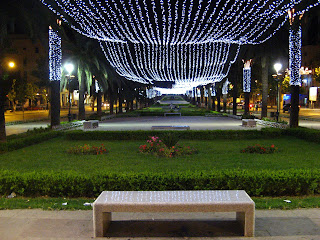Gamelan, the musical accompaniment, is an orchestra of percussion instruments, chiefly gongs, cymbals, hand drums, xylophones and metallophones. This arrangement of instruments is not exclusive to percussion, as flutes, strings, and vocals are also employed in the music. Gamelan is unique to Indonesia, and actually pre-dates the arrival of Hinduism and Buddhism.
Before the show began, the artists burned incense on the stage, making the performance the feel like a genuine Hindu ceremony. Just as the artists took the stage, the call to prayer began from a near by mosque: it was a very cool contrast.
There were six musicians in all, and four dances – only one male, but was the leader of the troupe. Within Balinese Hinduism, music and dance go hand-in-hand; although, not surprisingly, I was much more interest in the musical aspect of the performance.
The orchestra consisted of two metallophone players, one gong player, one cymbal player, one percussionist, and a flutist. For several songs, additional, extra-large, flutes (or, some sort of wood-wind instrument) were brought out.
The percussion often played his drum with a stick in his right hand, and just with his palm on the left side of the drum. The drum was very similar to a South Indian dholak, although it was a bit larger. I am sure there is a direct lineage between this drum and the dholak, as it is only logical to conclude that with the musical instruments of India arrived to Bali in tandem with the emergence of Hinduism to the island.
The metallophones were the most interesting aspect of the performance: each instrument was laden with a series of beautiful carvings and paintings in red, black and gold. The craftsmanship truly was outstanding – not to mention the sound of the instruments was exception. The metallophone is played with a hammer; the hammer strikes a metal bar, and then the musician quickly grabs the metal bar to control the reverberations, to augment or lessen the sound. These metallophones are specifically called “gangsa” – a metallophone specific to Indonesia. (Metallophones are found all around the world; the most common example of one is the glockenspiel).
Most impressively, the two metallophone players always stayed in sync with one another: absolutely amazing mutual coordination, considering the complexity (and speed) of the scales they were playing. The rapid, staccato movement across the metal bars was fascinating to watch. The music had a scurrying feel to it that fit seamlessly to the dance sequences.
Because the performance was both music and dance, each song, or piece rather, was very long. While I, admittedly, did not pay much attention to the dancing, it was enjoyable to watch the dancers move to the rhythm of the music. Furthermore, the costumes of the dancers, specifically the masks, were all quite stunning in terms of the intricacy of the detail. The dancers frequently changed their masks, as each mask represented a different deity or religious figure – each time the dancer removed a mask, a short prayer was made.
The backdrop of the gate was incredible; a truly perfect setting for traditional music. I was thrilled to be able to see a Balinese gamelan performance, as on my original itinerary for the fellowship (way back when I was first drafting the proposal in August 2006), I had selected Bali as my first destination, because of the large Hindu diaspora there. For various reasons (well only one actually, that the U.S. State Department had listed Bali as unsafe for travel, due to a series of recent bombings), I had to alter my itinerary, and replaced Bali with Fiji. I have no regrets, though!
Photographs and videos, below; more posts about the Fes Festival to come...



























No comments:
Post a Comment